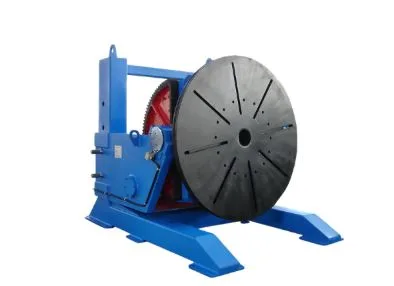Weld Positioners: Enhancing Efficiency and Precision in Welding Applications
Understanding Weld Positioners
A weld positioner is a mechanical device specifically used to hold a workpiece and aid in welding processes by moving it to the required angles or rotating it. With weld positioners, the workpiece is maintained to a certain level of professionalism and welding frameworks. All workpieces vary and in order to retain precision, consistency, and efficiency, angle or rotation is provided to it. They are used in construction work, the automobile industry, aerospace, and equipment manufacturing.
Click here to read more about the Welding Positioner Manufacturer in China – Zhouxiang
Types of Weld Positioners
Weld positioners are classified in a number of ways, each with legs and use-specific to a certain workpiece. Common examples are:
Headstock and Tailstock Positioners: These are utilized in long or tubular workpieces. The provided support for the workpiece is through rotation, angular adjustments, and is also precise.
View Welding Positioner for sale – Zhouxiang for More Details.
Turntables: The best use of flat rotating platforms in cylindrical or symmetrical workpieces is through turntable positioners. They aid in continuous welding.
Tilt-rotary Positioners: These are considered for complex welding tasks as they offer the ability to both turn and tilt.
Gear-Driven Positioners: For heavy-duty work, these are the best. The mechanisms used are a strap for large, heavy workpieces in a stable and precise manner.
Gripper Positioners – These devices have an integrated clamping system that ensures grasping of poorly formed or unusual components that need welding from the best position.
Key Features of Modern Weld Positioners
Modern weld positioners are equipped with advanced features that enhance their versatility and performance. Key features include:
Variable Speed Control – Provides precise control over the rotation and tilting for different welding processes.
Automation Integration – Many positioners can be integrated with robotic welding machines which increase automation and productivity.
High Load Capacity – Designed to maintain stability and safety while supporting bulky loads.
Ergonomic Designs – Improve accessibility to the weld area while minimizing fatigue to the operator.
Customizable Configurations – Flexible and can be tailored to numerous workpiece geometries.
Safety Features – Often includes functions like emergency stop buttons, overload protection, and locking devices, ensuring safety while operating.
These features make positioners crucial in the precision welding field with their ability to improve the quality of welds as well as the efficiency of operations performed.
The Importance of Weld Positioners in the Industry
Weld positioners are critical for optimizing welding operations, ensuring accurate, consistent control over workpiece positioning with minimal effort. Complex weld maintenance poses a risk of rework and inefficiencies without positioners, leading to productivity downtime. Streamlining adjustments to angle and position, positioners reduce operator fatigue and improve ergonomics, enhancing productivity. Their importance is even more pronounced in industries with stringent requirements such as aerospace, automotive, and heavy machinery.
Benefits of Using Weld Positioners
The adoption of weld positioners provides numerous benefits that directly impact productivity and welding quality.
Enhanced weld quality – Consistency and precision in workpiece positioning enable welders to maintain proper technique, strengthening and ensuring consistency in welds.
Enhanced worker safety – Reduced manual handling of heavy workpieces lessens the strain, which is more ergonomically favorable for the weld operator.
Time savings – Production and setup times are greatly reduced because of easy adjustability and automation, leading to increased throughput.
Cost efficiency – Operational costs are lowered as a result of positioners reducing errors, material waste, and operator fatigue.
Industry Trends in Weld Positioners
Like other sectors of the economy, the welding industry is adopting new technologies, and this is also true in the case of weld positioners. Trends include the automation of robotic systems as well as their compatibility and integration with Industry 4.0. The use of smart positioners with built-in sensors and software for monitoring and error detection systems is on the rise. The positioners that are more in demand now are the ones that have environmentally friendly features and are innovative for energy conservation. All these developments guarantee that positioners in welding are still the tools of choice that fit the requirements of modern industries and the changing environments of manufacturing.
How Weld Positioners Improve Welding Efficiency
Improving Accuracy in Welding Through Positioners
Positioners are critical for achieving precision in every step of the welding process, as they ensure that work pieces are held in place during rotation. This, in turn, enables welders to reach complex angles with ease, thus achieving uniform welds. Moreover, the contemporary advanced control systems incorporated into modern positioners allow for fine adjustments to be made to control positions during the welding process. This feature is more advantageous for the aerospace and automotive industries, which are characterized by stringent precision and quality standards. Positioners enhance precision thus leading to improved weld quality and more reliable products.
Minimizing Expenses and Time Duplication
The automation and efficiency offered by positioners ensure that there is a reduction in the time needed to finish a project while also lowering the functional expenses of an organization. These tools also reduce the need for manual work in relation to the placement and lifting of components; work is done in sections. With positioners in place, there is also a reduction in errors that lead to duplication of work, which is usually costly in an industry. The further integration of positioners in Automated Welding Systems provides an additional advantage in relation to systems and the work done, higher throughput quality and competitive production quality is guaranteed.
Improving Safety with Weld Positioners
Weld positioners impact safety at the workplace in numerous ways. They reduce the possibility of welders suffering from fatigue and lifting injuries by preventing them from bearing burdensome and awkwardly shaped workpieces. They enable welders to keep their bodies in a more ergonomically favorable positions, thereby reducing strain during long physical operations. In addition, their emphasis on safety and injury avoidance also helps reduce the possibility of accidents caused by sudden workpiece slips and misalignment. Positioners also provide controlled and stable movement of the workpieces. Such a work environment not only protects the welders but also improves overall productivity.
Choosing the Right Weld Positioner for Your Needs
Major Factors to Keep In Mind While Choosing a Positioner
Positioner selection factors go hand in hand with achieving optimal welding efficiency and precision. Critical factors include the positioner’s load capacity, speed control, and the angle of rotation. Equally important is the positioner’s ability to handle the workpiece weight. Underloading a positioner with insufficient capacity can cause mechanical strain and safety issues. Also, every welding process is different, and thus, it is important that the welder has the ability to rotate the positioner to match the speed of the welding process. Moreover, some tasks require full 360-degree rotation, some require particular angular adjustments, and hence, the rotation angle is equally important. Focusing on these factors make sure that the equipment complements the workflow.
Assessing Product Specifications
To ensure that a weld positioner aligns with a given application, it is important to scrutinize product specifications. As with any equipment that involves welding, verifying torque and tilt functionalities is a good starting point. Moreover, torque and tilt functionalities should adequately accommodate the materials to be welded. It is also important to analyze the chuck type and the general shape of the positioner, since they determine the gripper’s holding strength with the workpiece. Another important specification that requires attention is the inter-compatibility of the positioner with other auxiliary tools or automation equipment, and thus, equipment compatibility is a very important factor. Many manufacturers also indicate the hardware’s sensitivity to wear and tear, as well as energy consumption, which affects performance, economy, and efficiency in the long run.
Common Indecisiveness in Choosing Weld Positioners
Selecting a weld positioner can often become a puzzle to solve since one has to pick the best suited to their needs. A typical risk is a lack of insight into an increase in work; this can lead to a scenario where one has machinery that cannot handle a bigger workload. Underestimating the workload that a project involves, ignoring the scope of the project, can lead to surplus procurement expenditure. Problems can also occur where incompatible parts of a welder exist that are already in automation or specific processes, since the work can infringe upon the timeline of the entire project. Moreover, it can also become hard to determine the models that one needs since a variety of models is available, balancing the requirement of functionality with cost is a delicate task. The ability to perceive these risks can help tailor bespoke solutions that can tackle these issues with the needed precision.
FAQs About Weld Positioners
What Are The Common Accessories For Weld Positioners?
To increase their usability for particular jobs, weld positioners are regularly used with different accessories. Accessories such as chuck jaws, which firmly hold workpieces, are common. Elevation stands and tilting devices are used for the height and angle adjustments for optimum positioning of the positioner. Hands-free operation is enabled by the use of remote and foot pedals for rotational control, which is critical for safety, efficiency, and precision. Moreover, custom fixtures, faceplates, and adapter plates for easy integration and complex welding needs are provided.
How Can I Maintain My Weld Positioner?
Reliability and the long life of a weld positioner is directly related to maintenance, which makes proper maintenance practices critical. Check all weldery, such as gears, bearings, and all rotating assemblies, for regularly scheduled inspections and wear out. Following the lubrication policies of the manufacturer will allow for friction control, thus. Moving parts will be operationally life-extending. Controls and wires for the electrical systems also need to be checked regularly to maintain proper functioning and work with no interruptions. For proper performance, the equipment needs to be cleaned after every use with particular attention to dusty and dirty environments. Optimal operation is a result of properly following all policies of the manufacturer’s recommended maintenance schedule.
What Are the Results of Using a Weld Positioner?
The application of a weld positioner within a manufacturing system enables precise spatial control and optimal posture for the welder, which leads to remarkable improvements in welding accuracy and quality. Accuracy and control of the weld seam improve when optimal angles for the weld are maintained and consistent welder control is exercised, which reduces the probability of defects. In addition, improvement in the accuracy of process control leads to enhanced process efficiency, decreased time for cycles, and improved resource allocation. From a safety perspective, weld positioners reduce the risk associated with heavy manual handling of workpieces, improving safety in the workplace. Collectively, these factors lead to remarkable improvements in productivity, quality, and long-term expenditure.






